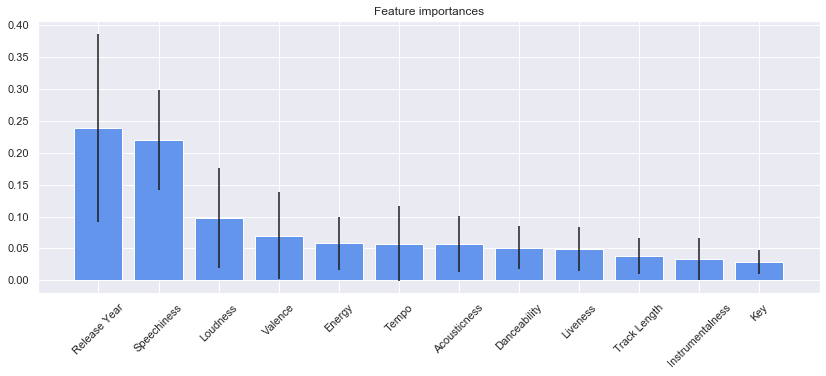Import all packages and authenticate Spotipy credentials
import pandas as pd
import numpy as np
import spotipy
from spotipy.oauth2 import SpotifyClientCredentials
import spotipy.util as util
username = 'drogers771'
scope=''
ccm = SpotifyClientCredentials(client_id=my_client_id,
client_secret=my_client_secret)
my_token = util.prompt_for_user_token(username,
scope,
client_id=my_client_id,
client_secret=my_client_secret,
redirect_uri='http://localhost:8889')
Let’s pick a popular artist. This time we will look at The Beatles
from spotipy.oauth2 import SpotifyClientCredentials
import sys
import spotipy
sp = spotipy.Spotify(client_credentials_manager=ccm)
def get_artist(name):
results = sp.search(q='artist:' + name, type='artist',market='US')
items = results['artists']['items']
return items[0]
artist = get_artist('The Beatles')
Grab all the albums for our artist above
albums = []
results = sp.artist_albums(artist['id'], album_type='album')
albums.extend(results['items'])
while results['next']:
results = sp.next(results)
albums.extend(results['items'])
unique = []
album_id = []
for album in albums:
name = album['name'].lower()
id_name = album['id']
if name not in unique:
unique.append(name)
album_id.append(id_name)
print('Total albums on Spotify:', len(unique))
Total albums on Spotify: 23
Grab all the songs on each of their albums
tracks = []
ids = []
Artist=[]
Album=[]
Track=[]
Track_Length=[]
for i in album_id:
results = sp.album_tracks(album_id=i)
tracks.extend(results['items'])
while results['next']:
results = sp.next(results)
tracks.extend(results['items'])
for track in tracks:
ids.append(track['id'])
Track.append(track['name'])
Artist.append(track['artists'][0]['name'])
Track_Length.append(track['duration_ms']/60000)
df_tracks = pd.DataFrame({'Artist':Artist,
'Track':Track,
'Track Length':Track_Length,
'Track ID':ids})
print(df_tracks.shape)
(534, 4)
Go back and grab some features such as when the album was released and tracks’ popularity
temp=[]
Artist=[]
Album_ID=[]
Album=[]
Album_Release=[]
Track=[]
Track_ID=[]
Popularity=[]
for row in df_tracks['Track ID']:
results = sp.track(track_id=row)
temp.append(results)
for i in temp:
Artist.append(i['artists'][0]['name'])
Album.append(i['album']['name'])
Album_ID.append(i['album']['id'])
Album_Release.append(i['album']['release_date'])
Track.append(i['name'])
Track_ID.append(i['id'])
Popularity.append(i['popularity'])
df_albums = pd.DataFrame({'Artist':Artist,
'Album':Album,
'Album ID':Album_ID,
'Album Release':Album_Release,
#'Track':Track,
'Track ID':Track_ID,
'Popularity':Popularity})
print(df_albums.shape)
retrying ...1secs
retrying ...1secs
(534, 6)
Grab features of each song like Energy, Loudness, etc.
audio = []
Danceability = []
Energy = []
Key = []
Loudness = []
Speechiness = []
Acousticness = []
Instrumentalness = []
Liveness = []
Valence = []
Tempo = []
track_id = []
for i in ids:
results = sp.audio_features(i)
audio.extend(results)
for i,j in enumerate(audio):
track_id.append(j['id'])
Danceability.append(j['danceability'])
Energy.append(j['energy'])
Key.append(j['key'])
Loudness.append(j['loudness'])
Speechiness.append(j['speechiness'])
Acousticness.append(j['acousticness'])
Instrumentalness.append(j['instrumentalness'])
Liveness.append(j['liveness'])
Valence.append(j['valence'])
Tempo.append(j['tempo'])
df_audio = pd.DataFrame({'Track ID': track_id,
'Danceability':Danceability,
'Energy':Energy,
'Key':Key,
'Loudness':Loudness,
'Speechiness':Speechiness,
'Acousticness':Acousticness,
'Instrumentalness':Instrumentalness,
'Liveness':Liveness,
'Valence':Valence,
'Tempo':Tempo})
print(df_audio.shape)
retrying ...1secs
retrying ...1secs
retrying ...1secs
retrying ...1secs
(534, 11)
Merge the previous two dataframes
df = df_tracks.merge(df_audio,on='Track ID')
df = df.merge(df_albums, on='Track ID')
Show the first five entries of the dataset
df
| Artist_x | Track | Track Length | Track ID | Danceability | Energy | Key | Loudness | Speechiness | Acousticness | Instrumentalness | Liveness | Valence | Tempo | Artist_y | Album | Album ID | Album Release | Popularity | |
|---|---|---|---|---|---|---|---|---|---|---|---|---|---|---|---|---|---|---|---|
| 0 | The Beatles | Come Together - 2019 Mix | 4.336667 | 6lSxM9BKcEZBSDKl2VODsF | 0.536 | 0.360 | 9 | -10.973 | 0.0408 | 0.0823 | 0.167000 | 0.0996 | 0.147 | 164.891 | The Beatles | Abbey Road (Super Deluxe Edition) | 5iT3F2EhjVQVrO4PKhsP8c | 2019-09-27 | 57 |
| 1 | The Beatles | Something - 2019 Mix | 3.037100 | 3S6N0Wbem9KV3DBcYNfXuv | 0.416 | 0.385 | 0 | -9.388 | 0.0279 | 0.0958 | 0.000005 | 0.2280 | 0.458 | 133.298 | The Beatles | Abbey Road (Super Deluxe Edition) | 5iT3F2EhjVQVrO4PKhsP8c | 2019-09-27 | 56 |
| 2 | The Beatles | Maxwell's Silver Hammer - 2019 Mix | 3.466217 | 0fnY9xlLJCgtBUBX9rNzDJ | 0.816 | 0.386 | 2 | -9.443 | 0.0382 | 0.4970 | 0.000093 | 0.3090 | 0.708 | 131.099 | The Beatles | Abbey Road (Super Deluxe Edition) | 5iT3F2EhjVQVrO4PKhsP8c | 2019-09-27 | 53 |
| 3 | The Beatles | Oh! Darling - 2019 Mix | 3.452433 | 3UHv8SSIkNUDRBUHJx3Cg6 | 0.437 | 0.669 | 4 | -6.524 | 0.0395 | 0.0344 | 0.003950 | 0.3470 | 0.514 | 173.670 | The Beatles | Abbey Road (Super Deluxe Edition) | 5iT3F2EhjVQVrO4PKhsP8c | 2019-09-27 | 55 |
| 4 | The Beatles | Octopus's Garden - 2019 Mix | 2.846667 | 3e1w0Wm0sH8nUYPArDkBG3 | 0.565 | 0.645 | 1 | -6.194 | 0.0332 | 0.1130 | 0.000625 | 0.1240 | 0.626 | 92.253 | The Beatles | Abbey Road (Super Deluxe Edition) | 5iT3F2EhjVQVrO4PKhsP8c | 2019-09-27 | 53 |
| ... | ... | ... | ... | ... | ... | ... | ... | ... | ... | ... | ... | ... | ... | ... | ... | ... | ... | ... | ... |
| 529 | The Beatles | Baby It's You - Remastered 2009 | 2.675333 | 2VmB1rF9FtfKUmFHDVnq8Q | 0.608 | 0.494 | 4 | -12.211 | 0.0345 | 0.7780 | 0.000000 | 0.0926 | 0.879 | 112.421 | The Beatles | Please Please Me (Remastered) | 3KzAvEXcqJKBF97HrXwlgf | 1963-03-22 | 58 |
| 530 | The Beatles | Do You Want To Know A Secret - Remastered 2009 | 1.950217 | 7Aobt67JnaF7qN8jCCKvHq | 0.673 | 0.349 | 4 | -12.414 | 0.0368 | 0.6080 | 0.000000 | 0.3800 | 0.609 | 124.451 | The Beatles | Please Please Me (Remastered) | 3KzAvEXcqJKBF97HrXwlgf | 1963-03-22 | 61 |
| 531 | The Beatles | A Taste Of Honey - Remastered 2009 | 2.058000 | 7fh53ta3vAOGJMQ4i5tCHe | 0.420 | 0.372 | 1 | -11.416 | 0.0327 | 0.6980 | 0.000000 | 0.1040 | 0.412 | 101.408 | The Beatles | Please Please Me (Remastered) | 3KzAvEXcqJKBF97HrXwlgf | 1963-03-22 | 47 |
| 532 | The Beatles | There's A Place - Remastered 2009 | 1.841550 | 4dessGxnKXmTbHPhVgqODq | 0.455 | 0.582 | 4 | -10.009 | 0.0292 | 0.6290 | 0.000004 | 0.1720 | 0.927 | 140.928 | The Beatles | Please Please Me (Remastered) | 3KzAvEXcqJKBF97HrXwlgf | 1963-03-22 | 47 |
| 533 | The Beatles | Twist And Shout - Remastered 2009 | 2.587100 | 5ZBeML7Lf3FMEVviTyvi8l | 0.482 | 0.849 | 2 | -9.198 | 0.0452 | 0.6410 | 0.000008 | 0.0414 | 0.937 | 124.631 | The Beatles | Please Please Me (Remastered) | 3KzAvEXcqJKBF97HrXwlgf | 1963-03-22 | 73 |
534 rows × 19 columns
Create new feature for year the album was released.
df['Release Year'] = df['Album Release'].str.split('-').str[0]
Attempting to get all tracknames to be written the same way. Some have (Live) or ‘- Remastered 2009’. Additionally, some tracks were just entered incorrectly in Spotify.
df['Track_New'] = df['Track'].str.replace(' \[| \(', '-').str.split('-',expand = True)[0].str.rstrip().str.lower()
df.groupby('Track_New').mean()['Track Length']
pd.set_option('display.max_rows', df.shape[0]+1)
df['Track_New'].value_counts()
df['Track_New'].describe()
count 534
unique 275
top sgt. pepper's lonely hearts club band
freq 11
Name: Track_New, dtype: object
It looks like there are a lot of duplicated songs. There may be some rereleases or greatest hits in the data that’s causing songs to appear more than once.
import matplotlib.pyplot as plt
import seaborn as sns
sns.set(style="darkgrid")
plt.figure(figsize=(10,6))
a = sns.boxplot(x=df['Release Year'], y=df['Track Length'])
a.set_prop_cycle(color=['blue'])
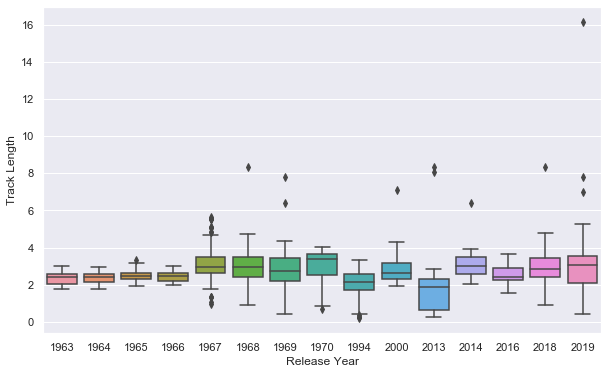
Track length dramatically changes after 1966! It looks like a few albums were release after 1970. Let’s see if the duplications go away when I remove thos albums.
df = df[df['Release Year']<='1970']
df['Track'].describe()
count 274
unique 244
top She's Leaving Home - Take 1 / Instrumental
freq 2
Name: Track, dtype: object
plt.figure(figsize=(10,6))
a=sns.boxplot(x=df['Release Year'], y=df['Track Length'])
a.set_prop_cycle(color=['red'])
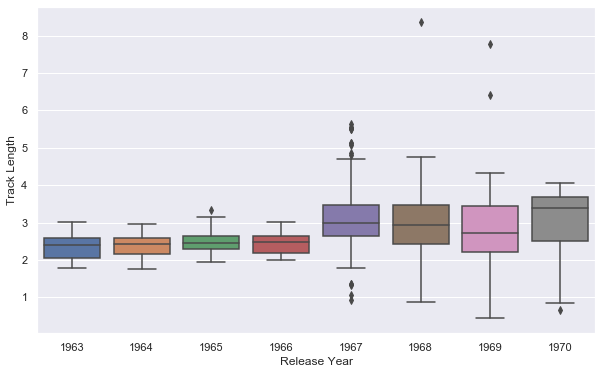
a=sns.distplot(df['Popularity'],bins=60)
a.set_prop_cycle(color=['red'])
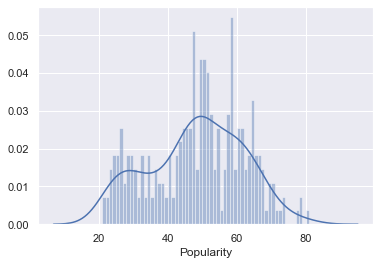
Now, I want to take a look at how the features are correlated. It doesn’t look like any of our features are highly correlated with our targe ‘ Popularity’
corr_df = df.corr()
plt.figure(figsize=(10,6))
a=sns.heatmap(corr_df, cmap="Blues")
a.set_prop_cycle(color=['red'])
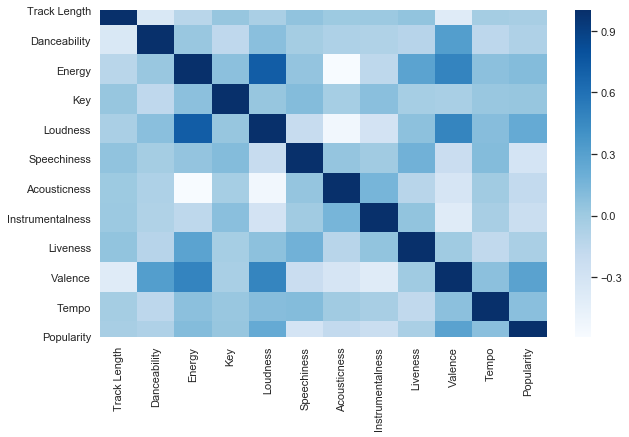
sns.pairplot(df)
<seaborn.axisgrid.PairGrid at 0x1b456a84648>
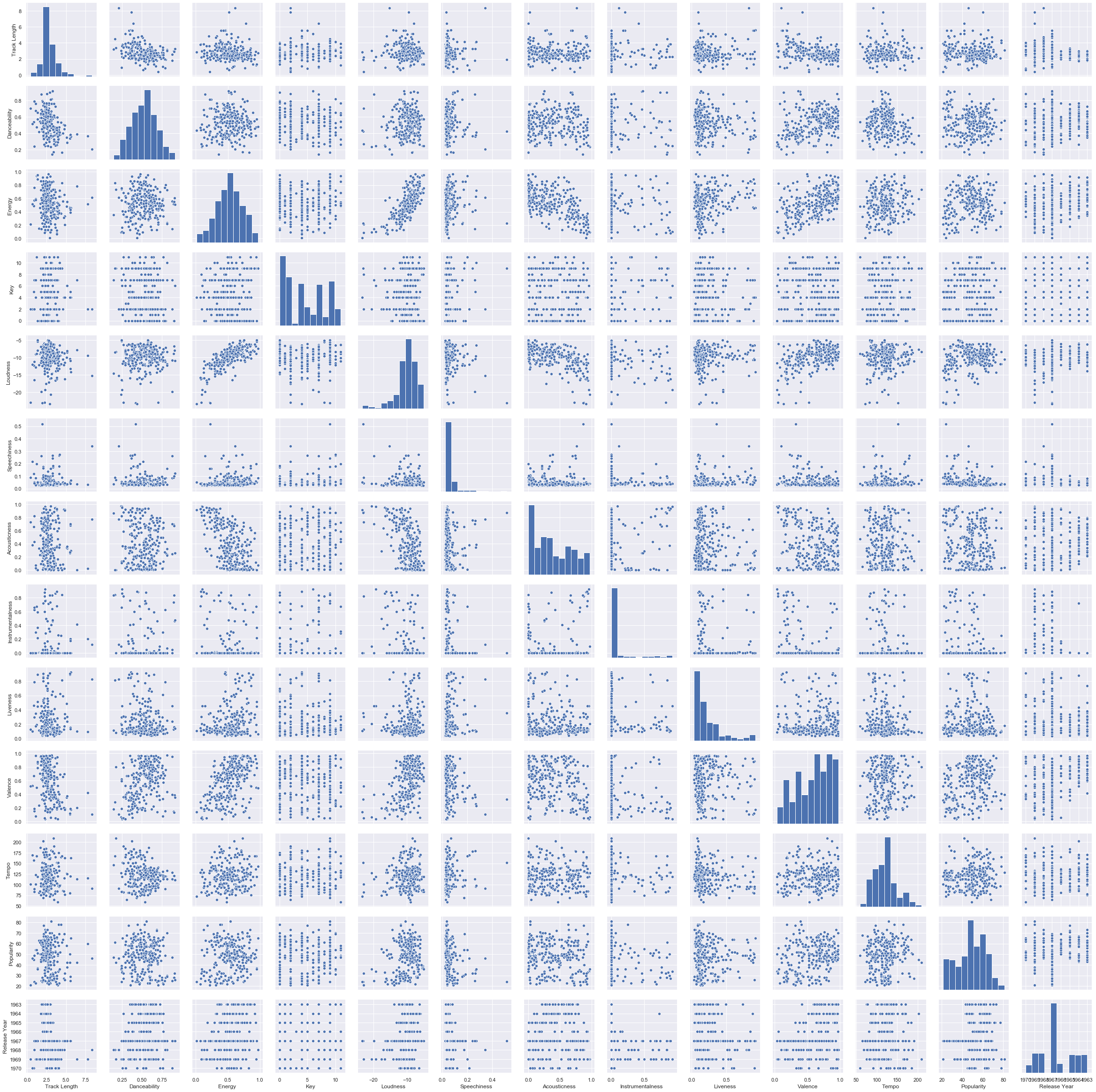
df['Release Year'] = df['Release Year'].astype(str)
C:\Users\roger\Anaconda3\lib\site-packages\ipykernel_launcher.py:1: SettingWithCopyWarning:
A value is trying to be set on a copy of a slice from a DataFrame.
Try using .loc[row_indexer,col_indexer] = value instead
See the caveats in the documentation: http://pandas.pydata.org/pandas-docs/stable/user_guide/indexing.html#returning-a-view-versus-a-copy
"""Entry point for launching an IPython kernel.
Modeling
Importing packages that I will need
from prettytable import PrettyTable
# Sklearn model selection
from sklearn.model_selection import train_test_split
from sklearn.model_selection import RandomizedSearchCV
# Sklearn metrics
from sklearn.metrics import mean_squared_error, mean_absolute_error, mean_squared_log_error
# Sklearn models
from sklearn.linear_model import Lasso, ElasticNet, Ridge, SGDRegressor
from sklearn.svm import SVR, NuSVR
from sklearn.ensemble import BaggingRegressor, RandomForestRegressor
from sklearn.neighbors import KNeighborsClassifier
from sklearn.cluster import KMeans
from sklearn.ensemble import RandomForestClassifier
from sklearn.ensemble import GradientBoostingClassifier
from sklearn.linear_model import LinearRegression
import random
%matplotlib inline
# Make results reproducible
random.seed(100)
df.columns
Index(['Artist_x', 'Track', 'Track Length', 'Track ID', 'Danceability',
'Energy', 'Key', 'Loudness', 'Speechiness', 'Acousticness',
'Instrumentalness', 'Liveness', 'Valence', 'Tempo', 'Artist_y', 'Album',
'Album ID', 'Album Release', 'Popularity', 'Release Year', 'Track_New'],
dtype='object')
x_columns = ['Track Length', 'Danceability','Energy', 'Key', 'Loudness', 'Speechiness', 'Acousticness',
'Instrumentalness', 'Liveness', 'Valence', 'Tempo','Release Year']
y_column = df['Popularity']
Splitting data into training and testing sets
X_train, X_test, y_train, y_test = train_test_split(df[x_columns],
y_column,
test_size=0.2,
random_state=42)
Running the data through 9 different models to see which model predicts my test data
table = PrettyTable()
table.field_names = ["Model", "Mean Squared Error", "R² score"]
models = [
Lasso(alpha=0.1),
ElasticNet(random_state=0),
Ridge(alpha=.5),
SVR(gamma='auto', kernel='linear'),
SVR(gamma='auto', kernel='rbf'),
BaggingRegressor(),
BaggingRegressor(KNeighborsClassifier(), max_samples=0.5, max_features=0.5),
NuSVR(gamma='auto'),
RandomForestRegressor( random_state=0, n_estimators=300)
]
for model in models:
model.fit(X_train, y_train)
y_res = model.predict(X_test)
mse = mean_squared_error(y_test, y_res)
score = model.score(X_test, y_test)
table.add_row([type(model).__name__, format(mse, '.2f'), format(score, '.2f')])
print(table)
+-----------------------+--------------------+----------+
| Model | Mean Squared Error | R² score |
+-----------------------+--------------------+----------+
| Lasso | 162.69 | -0.06 |
| ElasticNet | 174.85 | -0.14 |
| Ridge | 163.65 | -0.07 |
| SVR | 178.25 | -0.16 |
| SVR | 167.16 | -0.09 |
| BaggingRegressor | 156.23 | -0.02 |
| BaggingRegressor | 260.56 | -0.70 |
| NuSVR | 178.73 | -0.16 |
| RandomForestRegressor | 117.07 | 0.24 |
+-----------------------+--------------------+----------+
The random forest model has the lowest MSE and highest R². Below I am going to see if I can improve on that model
# Table setup
table = PrettyTable()
table.field_names = ["Model", "Dataset", "MSE", "MAE", 'RMSLE', "R² score"]
# Model training
model = RandomForestRegressor(bootstrap=True, criterion='mse', max_depth=None,
max_features='auto', max_leaf_nodes=None,
min_impurity_decrease=0.0, min_impurity_split=None,
min_samples_leaf=1, min_samples_split=4,
min_weight_fraction_leaf=0.0, n_estimators=200, n_jobs=None,
oob_score=False, random_state=None, verbose=0, warm_start=False)
model.fit(X_train, y_train)
def evaluate(x, y, dataset):
pred = model.predict(x)
mse = mean_squared_error(y, pred)
mae = mean_absolute_error(y, pred)
score = model.score(x, y)
rmsle = np.sqrt(mean_squared_log_error(y, pred))
table.add_row([type(model).__name__, dataset, format(mse, '.2f'), format(mae, '.2f'), format(rmsle, '.2f'), format(score, '.2f')])
evaluate(X_train, y_train, 'training')
evaluate(X_test, y_test, 'validation')
print(table)
+-----------------------+------------+--------+------+-------+----------+
| Model | Dataset | MSE | MAE | RMSLE | R² score |
+-----------------------+------------+--------+------+-------+----------+
| RandomForestRegressor | training | 14.67 | 2.90 | 0.09 | 0.92 |
| RandomForestRegressor | validation | 119.15 | 8.50 | 0.21 | 0.22 |
+-----------------------+------------+--------+------+-------+----------+
Feature importance
importances = model.feature_importances_
std = np.std([tree.feature_importances_ for tree in model.estimators_], axis=0)
indices = np.argsort(importances)[::-1]
Print the feature ranking
print("Feature ranking:")
for f in range(X_test.shape[1]):
print("%d. feature %s (%f)" % (f + 1, x_columns[indices[f]], importances[indices[f]]))
Feature ranking:
1. feature Release Year (0.238756)
2. feature Speechiness (0.220008)
3. feature Loudness (0.097321)
4. feature Valence (0.069859)
5. feature Energy (0.058355)
6. feature Tempo (0.057656)
7. feature Acousticness (0.057093)
8. feature Danceability (0.050881)
9. feature Liveness (0.049203)
10. feature Track Length (0.038286)
11. feature Instrumentalness (0.033633)
12. feature Key (0.028948)
Plot the feature importances of the forest
plt.figure(figsize=(14,5))
plt.title("Feature importances")
plt.bar(range(X_test.shape[1]), importances[indices], color="cornflowerblue", yerr=std[indices], align="center")
plt.xticks(range(X_test.shape[1]), [x_columns[i] for i in indices],rotation=45)
plt.xlim([-1, X_test.shape[1]])
plt.show()
